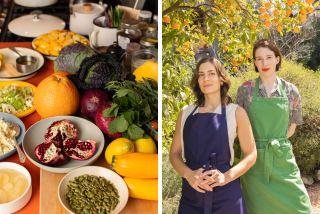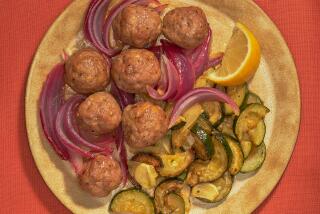Slow Down, Roast Yourself a Meal
The scent is a heady blend of rosemary, thyme and olive oil. Thereâs a sizzling sound as chicken skin renders its fat. And youâre unwinding, reading a book.
This scenario does not come from a microwave meal. And it certainly isnât something youâre going to experience when you open a carryout bag. As for relaxation, how enjoyable can standing in line at your local roast rooster joint really be?
Youâre more likely to achieve dinner-time serenity by preparing an oven-cooked meal. Think of how pleasurable it would be to forgo the kitchen timer as the fragrance wafting through the house tells you your food is ready. Imagine how satisfying it is to do something creative. Itâs almost impossible to experiment when youâre cooking as fast as you can. No wonder chefs, cookbook authors and even home cooks are rediscovering the oven.
âWith lifestyles so frantic, itâs so wonderful to have something you can walk away from,â says Linda Griffith, co-author with her husband, Fred, of âCooking Under Coverâ (Chapters, 1996). Although the Griffiths love to throw something on the grill, thatâs not the inspiration for their food memories.
âMost of my comfort foods are slow-simmered,â says Linda, who still remembers her grandmotherâs stuffed cabbage rolls and chicken fricassee. âOven-cooked recipes take little preparation. But the rewards are so wonderful. The house smells so good. Realtors say that baking cinnamon buns will fill the house with an appealing smell for perspective buyers. Oven-cooked entrees are even better.â
The Griffiths travel frequently, and even then theyâre drawn to oven entrees.
âSlow cooking may be a lost skill, so itâs inspiring when we see it,â says Fred. âEven in restaurants, I love seeing old-fashioned dishes such as venison stew or bigos [a Polish hunterâs stew].â
Chef Jean Johoâs Brasserie Jo in Chicago is one place to go for robust oven-cooked food. Joho is chef-owner of Everest restaurant, the ultimate in fine French dining in the Windy City. But when he wanted food that reminded him of his native Alsace, France, he opened a brasserie featuring Alsatian choucroute, roast leg of lamb, beef tongue, cassoulet and braised lamb shanks.
âWhen I was a child, we didnât have gas tops in Alsace,â says Joho. âWe had wood-burning ovens, which everyone used. The first course went in the top of the oven, the second course in the bottom. We used the entire oven at the same time.â
An American home cook might think of roast chicken as a big-deal Sunday night meal. In Johoâs home, roast chicken and a salad were fast food.
âIt was light and it was easy cooking. No one thought of buying a roast chicken,â he says. He enjoys oven roasting large cuts of meat or poultry. âI make every kind of roast imaginable: pork, beef, veal, lamb, chicken, turkey, duck and goose. I like roasted foods. You keep the whole pieces and slice as you serve. Meat with the bone on has more flavor and more moisture. I would never buy boneless chicken to roast.â
But donât think that oven cooking is only for carnivores.
Dara Goldstein, who is as drawn to a snowy winter day as some people are to a Caribbean beach in January, loves a meal of oven-roasted vegetables.
âI cook vegetables long and slow in the winter so their aromas fill the house,â says Goldstein, author of âThe Vegetarian Hearthâ (HarperCollins, 1996).
Winter vegetables--like turnips, Brussels sprouts, rutabaga, parsnips and celery root--are âcaramelized, sweeter, transformed by heat,â says Goldstein, who keeps a root cellar with potatoes and carrots from her garden. âOld carrots that are woody and donât look so good can be braised with maple syrup or brown sugar and are delicious.â
Goldstein, a professor of Russian at Williams College in Williamstown, Mass., was strongly influenced by simple peasant dishes when she developed her recipes. The challenging difference for her was to prepare vegetables that are long-cooked but still have texture. Her basic directions for winter vegetables produce a feast thatâs as satisfying as the finest roast.
Bennett is the author of âDinner for Twoâ (Barronâs, 1994).
JEAN JOHOâS ROAST CHICKEN BRASSERIE JO
1 (4-pound) free-range chicken
1 cup olive oil plus 2 to 3 tablespoons for pan
1 clove garlic, lightly smashed
2 tablespoons chopped mixed herbs (thyme, rosemary, tarragon and basil as desired)
Salt
Freshly ground pepper
1 carrot, cut into bite-size chunks
1 small or 1/2 large celery root, thoroughly trimmed and cut into bite-size chunks
1 large turnip, pared and cut into bite-size chunks
1 onion, cut into 4 to 6 wedges
1 small rutabaga, peeled and cut into bite-size chunks
1/4 cup Pinot Blanc de Alsace
2 tablespoons water
Place chicken in glass or stainless steel bowl. Add 1 cup olive oil, garlic, mixed herbs and salt and pepper to taste. Turn chicken over several times to coat with oil. Cover bowl and refrigerate 8 to 24 hours, turning chicken occasionally to coat.
Place chicken on 1 side in roasting pan coated with 2 to 3 tablespoons olive oil. Discard oil and herb marinade. Add carrot, celery root, turnip, onion and rutabaga to pan. Season chicken and vegetables with salt and pepper to taste.
Roast chicken at 425 degrees 15 minutes. Turn chicken to second side, baste with pan juices and roast another 15 minutes. Turn chicken breast side up and baste and roast until chicken juices run clear when pierced with fork and vegetables are tender, 15 to 20 minutes.
When done, remove chicken and vegetables from pan. Pour off fat and add wine to pan. Cook on stove top over medium-high heat, scraping up any browned bits, until wine is reduced to 2 tablespoons, 3 to 4 minutes. Add 2 tablespoons water.
To serve, cut chicken into 4 serving pieces. Place on platter with vegetables. Pour wine mixture over chicken. Serve immediately.
4 servings. Each serving:
669 calories; 288 mg sodium; 174 mg cholesterol; 49 grams fat; 10 grams carbohydrates; 44 grams protein; 1.28 grams fiber.
ROASTED WINTER VEGETABLES
4 pounds assorted vegetables, such as beets, carrots, celery root, yellow onions, parsnips, potatoes, rutabagas, sweet potatoes and turnips, peeled and cut into bite-size chunks or wedges
2 tablespoons plus 2 teaspoons olive oil and extra for greasing pan
1 tablespoon plus 1 teaspoon balsamic vinegar
1 teaspoon crushed dried thyme
1/2 teaspoon summer savory
Salt
Freshly ground black pepper
This recipe is adapted from âThe Vegetarian Hearth,â by Dara Goldstein. Dried chervil or tarragon could be substituted for the summer savory.
Place assorted vegetables in oiled roasting pan. Combine oil and vinegar and sprinkle over vegetables. Sprinkle with 1 teaspoon thyme and 1/2 teaspoon summer savory or to taste. Season to taste with salt and pepper.
Roast at 425 degrees until vegetables are tender and browned, shaking pan occasionally so vegetables donât stick, about 45 minutes.
4 main-dish or 8 side-dish servings. Each side-dish servings:
135 calories; 96 mg sodium; 0 cholesterol; 5 grams fat; 22 grams carbohydrates; 2 grams protein; 2.14 grams fiber.
BEER-BRAISED VEAL BRISKET WITH ONIONS AND PARSNIPS
2 jumbo onions, thinly sliced
2 parsnips, thinly sliced
2 veal briskets (5 pounds total)
Salt
Freshly ground black pepper
1 teaspoon hot Hungarian paprika
1 teaspoon garlic powder
1 teaspoon dried thyme
1 (12-ounce) bottle spicy chili
sauce
1 cup beer
2 bay leaves
This recipe was adapted from âCooking Under Cover,â by Linda and Fred Griffith. Brisket tends to be a fatty dish, and the Griffithsâ directions are designed to eliminate the fat. You can serve the meat the same day as it is cooked, but you probably wonât be able to remove as much fat.
Place half of onions and all parsnips in heavy, nonreactive roasting pan. Place briskets, fat-side up, on onions. Rub evenly with salt and pepper to taste, paprika, garlic powder and thyme. Scatter remaining onions over brisket. Pour on chili sauce and beer. Place bay leaves over briskets.
Cover pan and roast at 325 degrees, basting occasionally, until meat is fork tender, about 2 1/2 hours. Remove from oven and place meat on large platter to cool.
Discard bay leaves. Wrap and refrigerate cooled briskets overnight. Puree pan gravy and vegetables in blender or food processor. Pour into container and chill overnight.
To serve, trim fat from briskets. Thinly slice meat across grain and place in oven-proof dish. Discard fat from surface of gravy and pour gravy over sliced meat. Cover dish and reheat at 325 degrees until hot, about 1 hour.
6 to 8 servings. Each of 8 servings:
324 calories; 668 mg sodium; 183 mg cholesterol; 7 grams fat; 18 grams carbohydrates; 43 grams protein; 0.93 gram fiber.
More to Read
Eat your way across L.A.
Get our weekly Tasting Notes newsletter for reviews, news and more.
You may occasionally receive promotional content from the Los Angeles Times.







